During the performance, there is no room for pain of the human within the Theyyam. The artist must jump into the fire pit not just once, but 101 times. This elevates the entire atmosphere, transporting devotees into a divine realm. At that moment, the artist is seen as a god, and gods do not feel pain, right?
Published Oct 30, 2024 | 4:00 PM ⚊ Updated Nov 07, 2024 | 4:51 PM

As another Theyyam season begins in Malabar, the tradition continues to call for sacrifice, highlighting how the human experience remains intertwined with the divine.
The Theyyam of North Malabar embodies the essence of living deities, intertwining humanity and divinity in a rich tapestry of spiritual expression. This sacred art form goes beyond mere performance; it revives ancient rituals that honour the body as a vessel for the divine.
In Theyyam, the challenges faced by the divine are deeply felt by the performer. These avatars endure hardships that set them apart from other rituals, where the weight of the gods’ sorrow often overshadows their human concerns.
The physical struggles of the performer become secondary as they channel the profound emotions of the deities.
Through this unique experience, the performer transforms the body into a sacred medium, reviving forgotten rituals of the past. Theyyam serves as a powerful reminder of the connection between the ethereal and the earthly, celebrating the meeting of sacred and human, the mystery of life.
As another Theyyam season begins, it is worthwhile recalling how this tradition is a demonstration of the human experience, which remains intertwined with the divine.
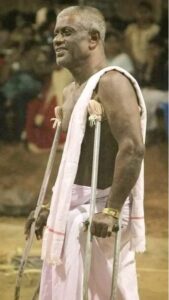
Kunjaran Peruvannan
Vishnu S. from Kannur, one of the youngest members of a family of Theyyam artists, shared his admiration for Kunjaran Peruvannan with South First. “I grew up watching Kunjaran perform in temples, and Theechamundi was his finest act. The concept behind Theechamundi is that Lord Vishnu has come to slay Hiranyakashipu, and it is Vishnu who checks whether Hiranyakashipu is hiding in the fire pit. In this context, the Theyyam artist embodies Vishnu.”
“During the performance, there is no room for the pain of the human within the Theyyam. The artist must jump into the fire pit not just once, but 101 times. This elevates the entire atmosphere, transporting devotees into the divine realm. At that moment, the artist is seen as god, and gods do not feel pain, right?,” asks Vishnu.
He explained that Kunjaran’s story is tragic. “He suffered a severe accident that resulted in burns to his legs, particularly affecting his toes. As his condition worsened, he was forced to amputate his finger. Unfortunately, the situation escalated, leading to an infection that ultimately required amputation of his leg.”
Vishnu recalls that Kunjaran Peruvannan, despite his injuries, remained active in Theyyam performances, often appearing with crutches in hand, singing thottams (the songs for Theyyam) in temples.
“His story illustrates the sacrifices made for the divine, shedding light on the profound connection between human suffering and devotion in the Theyyam tradition,” Vishnu says.
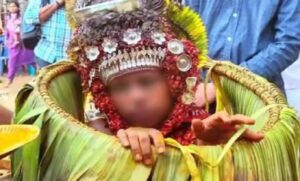
The kid who got seriously burned while performing Theyyam
Last year, the Theechamundi Theyyam drew national attention as NGO Dhisha filed a Public Interest Litigation (PIL) in the Kerala High Court seeking to ban children from participating in the ritual dance.
Known as Ottakolam Theyyam, this performance is organised by the Chirakkal Kovilakam and the Chirakkal Temple Trust as part of their annual festivities.
The NGO argued in its petition that the practice has detrimental effects on the health and safety of child performers, infringing upon their fundamental right to life.
It pointed out that the children involved typically come from marginalised communities. The issue gained even more attention after a viral video surfaced on April 7, showing a Class 8 student who suffered burns during the performance.
The footage depicted the child appearing exhausted and scorched after jumping into flames 101 times at the Chamundi Kottam Festival Ground, near the Chirakkal Temple.

Bappuran theyyam
While most Theyyam performances evoke deep devotion and tears among devotees, the Bappuran Theyyam of Malabar is quite different. This performer must climb a coconut tree during the act to bring laughter to the audience.
However, in the last week of February 2017, the entire state of Kerala mourned for the Bappuran Theyyam.
At the Meenkunnu Muchiriyan Temple in Azheekkal, a tragedy unfolded when renowned Theyyam artist Sumesh Peruvannan, 40, was performing. During his act, he showcased his acrobatic skills by climbing a tall coconut tree without any safety harness. In a heartbreaking moment, he suddenly lost his grip and fell, sustaining serious injuries.
Having performed this Theyyam for over a decade at the temple, Sumesh’s accident left him in need of extensive medical treatment at a specialised hospital in Mangalapuram.
His fans were unaware of his financial struggles until an account was opened to help with his medical expenses. By the ‘grace of God’, he made a remarkable recovery and returned to the stage after a year.
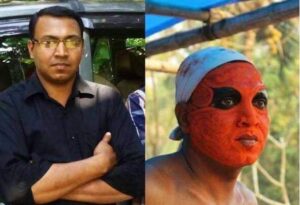
Sumesh Peruvannan
Babu Godhavarman, a Theyyam artist from Nileshwaram, Kasaragod, expressed his feelings to South First: “We perform not just for money; it’s self-expression of the divinity that we inherit from our ancestors. Unfortunately, many in the younger generation are not interested in continuing this tradition, so we must uphold it until we pass. Injuries during performances, especially from burns, are common, and afterward, we manage with minimal resources. However, the recognition we receive while in Theyyam attire is immense — people see us as gods, which is truly a blessing.
“We spend over ₹50,000 for each performance on flowers, assistants, and other expenses, but we cannot negotiate our wages since it is viewed as a divine ritual. Most of us are paid only during four months of the year, and that is often the only source of income for many of us. Some artists choose to perform Theyyam outside of our community, but I usually refrain from doing that. Additionally, there are no special pension schemes for Theyyam artists; we receive only ₹1,500 a month like everyone else. If any accidents occur, our families are the only ones who look after us,” Godhavarman said.
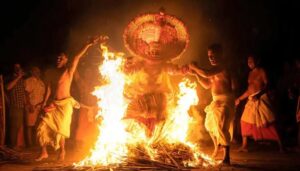
Theechamundi Theyyam
Pranav P., also from Nileshwaram near Anjoottambalam Veerarkavu, and part of a Theyyam artist family, recounted the recent incident. “I witnessed a massive accident for the first time in my life. It’s unbelievable. We typically don’t use large firecrackers during performances, but an unfortunate incident occurred yesterday. Still, the artists, including my relatives, didn’t want to stop performing Theyyam. Outsiders may try to connect it with logic, but Theyyam is ingrained in Malabar’s soul. People from around the world flock here during Theyyam season, and the numbers are growing each day.”
Sharath from Nileshwaram, who witnessed the explosion at the Anjoottambalam Veerarkavu Kaliyattam Festival yesterday, told South First: “The incident was unfortunate, yet the Theyyam event held yesterday was crucial for the community. The Theyyam season in Malabar starts with this temple, and different communities perform Theyyam for their respective areas. Unfortunately, the explosion disrupted many rituals.”
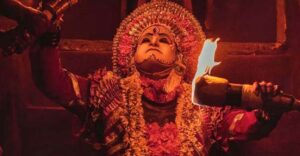
Panchuruli Theyyam in the movie Kantara
Kishor KN from Kasaragod, whose family conducts Theyyam in their ancestral home each year, told South First, “Yesterday’s incident was one of the rarest occurrences in Kasaragod. Theyyam in Kasaragod is also distinct from that in Kannur. Some of the most important Theyyams in Kasaragod include Vishnumoorthy, Theechamundi, Karichamundi, and Panchuruli. The latter gained worldwide attention after the release of the movie Kantara, attracting many researchers. Most Theyyam performances involve fire, with Theyyams like Pottan Theyyam and Gulikan Theyyam, that include jumping into a fire pit. It is believed that the gods are performing, not humans. As a result, most devotees don’t even think about the pain they endure.”
Anitta Ancy Jose, a Theyyam enthusiast from Kerala, attempted to draw out the contrast between logic and divinity: “The story behind Theyyam in Malabar is interesting. Theyyam is not just a religious act; it has many social justice elements. During a time when marginalised communities were not permitted inside temples, this group created their own god, who can hug humans, regardless of whether they are Muslim or Christian. This is a god who drinks alcohol and eats meat. Most of the Theyyams do not have that Brahmanical element of untouchability.”
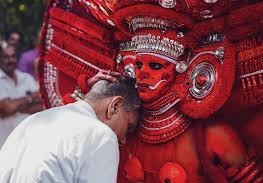
Theyyaam interacting with people
Anitta continued, “I ate chicken biryani at a Theyyam event. They don’t ask your religion, caste, or identity. It is a common view in Malabar that Muslims even hug Theyyam and cry out, expressing their sorrows to the god in front of them. It’s a ventilation process, actually.”
Discussing the vibrant colors used in Theyyam, she remarked, “When you observe the colors —red, black, yellow, etc. — it is evident that these are easily affordable to marginalised communities, unlike in other traditional art forms in Kerala, which are exclusively for the elite. The politics that Theyyam offers is inclusivity. An interesting fact is that many of the Theyyam artists are hardcore communists, comrades.”
Of the firecracker accident that left about 150 injured, she said, “Such incidents are painful, but we can’t separate Theyyam from Malabar. That is a matter of emotion, not logic; it is another world of divinity, spiritual experience, art, and politics.”
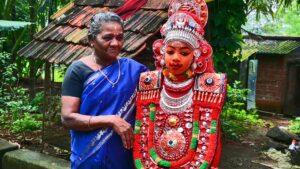
Aadivedan Theyyam(Kutti Theyyam)
Children also play an active role in the Theyyam tradition, particularly during Onam rather than during the main Theyyam season. In Palakkad and Kolathunadu, the performance of ‘Kutti Theyyam’ comes to life, marking the arrival of Aadivedan Theyyam.
This ceremonial figure visits homes to dispel the hardships associated with Karkkidakam (the month of hardship that coincides with the monsoon in the Malayalam calendar) and to usher in the prosperity of Chingam, the first month of the traditional calendar.
Aadivedan embodies the Siva-Parvathy concept and manifests in two forms: single and double.
The single form represents the ‘Ardhanareswara’ concept, while the double form consists of Aadi and Vedan. Vedan makes the first appearance, followed by Aadi midway through the month. Children from the Vannaan tribe portray Aadi, while those from the Malayan tribe take on the role of Vedan.
Accompanied by the rhythmic beats of the Chenda, a traditional drum, Aadivedan’s journey is marked by songs and chants. However, music only begins when Aadivedan arrives at households. After the performance, ‘Guruthi’ water is poured around the Nilavilakku, symbolising the purification of sins. As a token of gratitude, Aadivedan is presented with offerings of money, rice, coconut, and cucumber.
A minor Theyyam artist from Taliparamba, Kannur, expressed his deep commitment to this traditional art form: “The crown I wear is quite heavy. I often have to walk several kilometers while performing, and it can be painful at night. However, my love for this art keeps me going. During the Onam season, we visit homes to bless people, and they generously offer us money as a token of appreciation. That serves as pocket money. When I perform at my friends’ houses, I sometimes struggle to hide my smile. Yet, once I don the Theyyam costume, I truly become Aadivedan, embodying the spirit of the deity I represent.”
(Edited by Rosamma)
